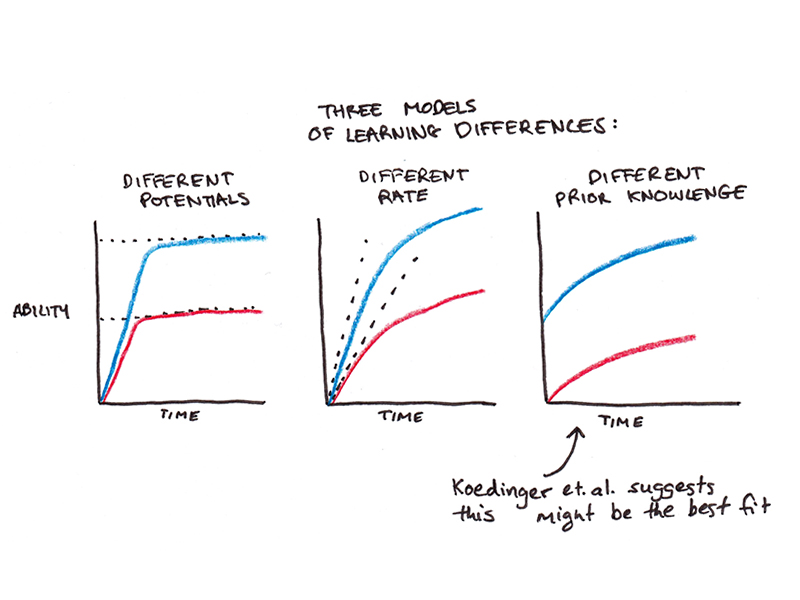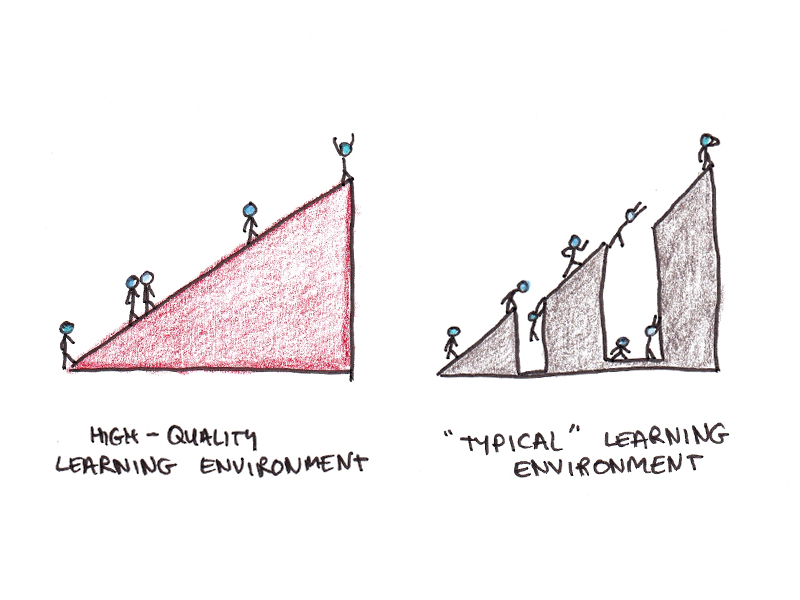Lately, I wrote a protection of psychologist John Carroll’s declare that what separated stronger and weaker college students wasn’t a elementary distinction in studying potential, however a distinction in studying fee. Some folks be taught sooner and others extra slowly, however supplied the proper surroundings, primarily anybody can be taught something.
In arguing that, I primarily wished to dispute the frequent perception that expertise units laborious limits on the ability and information you may ultimately develop. Not everybody might grow to be a physician, physicist or artist, the reasoning goes, as a result of some folks will hit a restrict on how a lot they will be taught.
Nevertheless, in arguing that the first distinction between college students was studying fee, I’ll have additionally been committing an error!
A current paper I encountered means that the speed of studying amongst college students doesn’t really differ all that a lot. As a substitute, what differs principally between college students is their prior information.1

“An Astonishing Regularity”
The paper, “An astonishing regularity in pupil studying fee,” was authored by Kenneth Koedinger and colleagues. They noticed over 6000 college students engaged in on-line programs in math, science, and language studying, starting from elementary faculty to school.
By delivering the fabric by way of on-line programs, the authors might fastidiously monitor which classes, quizzes and assessments the scholars took.
The authors then broke down what college students had been studying into information parts, and created a mannequin that outlined the person elements chargeable for studying every matter.

The mannequin breaks what college students be taught into prior information inferred from their efficiency on check objects earlier than instruction begins, and a measure of latest studying. The precise particulars of the mannequin are a bit of technical, so should you’re , you may learn the paper or see this footnote.2
Instantly, the authors noticed that college students enter courses with substantial variations in prior information. The typical pre-instruction efficiency was 65%, with extra poorly performing college students at 55% and higher performing college students at 75%.
This distinction in prior information translated to differing volumes of follow wanted to realize mastery, which the authors outlined as an 80% likelihood of success. Robust college students wanted roughly 4 alternatives to grasp a given information element, whereas weaker college students required greater than 13. A dramatic distinction!
Nevertheless, the speed of studying between sturdy and weaker college students was surprisingly uniform. Each teams improved on the identical fee—attaining roughly a 2.5% enhance in accuracy per studying alternative. It was merely that the higher college students began with extra information, so that they didn’t have as far to go to succeed in mastery.
Whereas the authors did discover a slight divergence in studying charges, it was dwarfed by the impression of prior information. In keeping with this mannequin, college students required a median of seven follow exposures per information component to realize mastery. When the extent of prior information was equalized between “quick” and “gradual” learners, the “gradual” learners solely wanted one further follow alternative to equal the speed of the “quick” learners.
If All Learners are Equally Quick, Why Do Some Have So A lot Extra Information?
This outcome shocked me, however it wasn’t the primary time I’ve encountered this declare. Graham Nuthall made the same remark in his intensive analysis in New Zealand school rooms, discovering that college students required roughly 5 alternatives to be taught a given piece of data, and the speed didn’t differ between college students—though prior information did.
Nonetheless, it raises an apparent query: if studying charges are equal, why do some college students enter courses with a lot extra prior information? Some potentialities:
- Some college students have backgrounds outdoors of college that expose them to better information. One of many well-known outcomes of early vocabulary studying is that kids from prosperous backgrounds are uncovered to much more phrases than these from poor and working-class socioeconomic backgrounds.
- Some college students is likely to be extra diligent, curious and attentive. The authors be aware that their studying mannequin matches the info a lot better if you rely studying alternatives, not calendar time elapsed. Thus, if a pupil will get much more studying alternatives inside the identical class (by being attentive to lectures, doing the homework, and so forth.) than a classmate, they’ll have dramatically completely different general studying charges, even when their studying fee per alternative is identical.
- Maybe studying fee is uniform solely in high-quality studying environments. A standard discovering all through academic analysis is that decrease aptitude college students profit from extra steering, express instruction and elevated assist. It is likely to be the case that studying charges diverge for much less learner-friendly environments than the one studied right here.

One other risk is that small variations in studying charges are inclined to compound over time. Those that be taught sooner (or got extra favorable early studying environments) may search out extra studying and follow alternatives, leading to larger and greater variations amassed over time.
In studying analysis, Keith Stanovich was one of many first to suggest this Matthew impact for studying capacity. These with a bit of bit of additional capacity in studying discover it simpler and extra pleasing to learn, get extra follow, and additional entrench their capacity.
Nonetheless, a countervailing piece of proof to this view is the truth that the heritability of educational capacity tends to extend as we become older. Youngsters’ genes are extra predictive of their intelligence than youthful kids’s genes are. That form of sample doesn’t make sense if we imagine massive gaps in tutorial capacity are merely because of constructive suggestions loops—that may recommend those that, by way of random elements, had been above their predicted potential would proceed to entrench their benefit, relatively than regress to the imply.
These remaining questions apart, I discovered Koedinger’s paper fascinating, each for offering a provocative speculation concerning studying, and their effort to systematically mannequin the information parts concerned in studying, providing a finer-grained evaluation than many experiments that rely solely on a number of assessments.
Footnotes
- Due to Barbara Oakley for bringing the paper to my consideration!
- The authors mannequin efficiency of pupil i on process j. Key to the equation is the matrix q, which fashions the efficiency on check objects by fundamental information parts. The constructing blocks of data have to be inferred primarily based on check efficiency, relatively than noticed instantly, so every attainable q represents a speculation about which information parts are concerned in a given tutorial and evaluation episode. Given pupil knowledge, q is calculated to greatest match the precise pupil efficiency knowledge.

